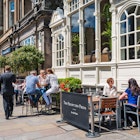
Jun 3, 2023 • 4 min read
Jan 10, 2022 • 7 min read

Kamatama udon is among the most popular styles of udon in Kagawa Prefecture © Said Karlsson / Lonely Planet
Writer Brian Ashcraft travels to Kagawa Prefecture with an empty stomach and a singular mission: Eat noodles.
It's almost 7am and I’ve already been driving for two hours. The morning sun glows hot over the water as my Volvo races across the Onaruto Bridge, a pearl-colored crossing suspended over a narrow strait. In a few hours, the tourist boats will arrive, bringing people to view the Naruto whirlpools that swirl below. The kids are asleep in the backseat and my wife snoozes on the passenger side. I have one thing on my mind: noodles.
{
"url": "udon-noodles-shikoku-japan",
"destination": "Shikoku",
"continent": "Asia",
"country": "Japan",
"region": "Shikoku"
}Scotland might have the malt whisky trail and Kentucky a bourbon one, but I, a whisky writer, am not heading to Kagawa in search of something to drink. I’m here to stuff as much Sanuki udon in my stomach as humanly possible.
Located on the island of Shikoku in Japan's Island Sea, Kagawa, or “Sanuki” as it was once known, is the smallest of the country's 47 prefectures. It’s also one of Japan’s most beautiful spots, filled with traditional villages and overflowing with excellent sake. I live a few hours away in Osaka, where I've called home since 2001, so this pilgrimage is within easy driving distance – and long overdue.

These days Kagawa is sometimes called “Udon-ken” or “Udon Prefecture,” because it is a place that’s synonymous with wheat flour noodles. Although Kagawa didn't invent udon, one theory suggests that a forerunner arrived there from China in the 8th century. The earliest depiction of udon restaurants in Kagawa date to a folding screen from the early 1700s. In it, a shirtless man with a topknot is seen kneading flour, while in a thatched-roofed shop up the street, a man with a knife slices the white dough into noodles. This is not the only place in Japan where the udon noodles are made or eaten, but Kagawa makes more udon than anywhere else in the country.

In 2009, Japan's agriculture ministry announced that the tiny prefecture used 59,643 tons of wheat flour for udon, which was double the second-place Saitama Prefecture. Kagawa, with its wheat fields and salt mines, has historically had what it needed to make the best noodles possible. Although the vast majority of wheat flour is now imported from Australia to save some yen and meet demand, the technique and know-how are forever Kagawa’s.

{
"url": "udon-noodles-shikoku-japan",
"destination": "Shikoku",
"continent": "Asia",
"country": "Japan",
"region": "Shikoku"
}I spent the night before my road trip poring over recommendations on Japanese websites, but it's not like finding a place to eat Sanuki udon is difficult. You cannot walk down the streets of any town in Kagawa without stumbling upon a noodle shop. They’re easy to spot: Just look for the restaurants with “udon” written in Japanese (うどん) or, easier still, the places with long lines out front. There are an estimated 600 to 800 udon restaurants in Japan’s smallest prefecture, which, at 725 sq miles, could easily fit in Rhode Island. This means that there are more udon restaurants than convenience stores in Kagawa, an impressive feat in konbini-crazy Japan. For the connoisseurs, the reputations of certain establishments have become legendary.
Since this is an all-day affair and many shops don’t open until 10 or 11, we make a beeline to our first stop, Udon Baka Ichidai, down an inconspicuous side street in the city of Takamatsu. It opens at 6am and is only closed on New Year's Day. You'd think that would satiate the demand, but when we show up a bit after 8, there's already a line out front. Inside, the walls are covered with celebrity autographs. The faithful patiently wait for their morning bowl.

When devoting an entire day to udon, you must know how to order. Some shops are self-serve, while others serve you. If you’re planning on hitting multiple restaurants, be aware of available sizes. Sho is small, or one helping of noodles, while chuu, or “middle,” is two helping of noodles, and dai is three. Some restaurants might do one and a half helpings for chuu, or might not even have sho on offer. Generally, if you're planning to sample a variety of Sanuki udon, pace yourself by going with the smallest size. The good news? Udon is cheap! One little bowl might cost as little as a dollar, with a piece of tempura thrown in for another buck.

Crack! I watch my youngest son open a raw egg into a small bowl. He beats the egg with his chopsticks and then pours it over the noodles, sprinkling green onions on top. Not bad for an 8-year-old. He slurps down some noodles, looking up only to smile. Sanuki udon is served in a handful of ways. This style is kamatama udon, with kama short for kamaage or "just from the boiling pot" and tama short for tamago or "egg." This style is so popular in Kagawa that Takamatsu’s professional soccer team is called Kamatamare Sanuki and features a bowl of noodles on its crest.
Other popular styles include kake udon, which is noodles in a soup broth, and bukkake udon, which is served with less broth or splashed with soy sauce. In Kagawa, the helpings of chopped green onions are generous, and the tempura sides are almost compulsory. Once we finish our morning snack, we’re out the door in search of the next spot.

I could eat udon all day. I am eating udon all day. But udon wasn’t always my first choice for noodles. I spent a good deal of my twenties hunched over bowls of ramen, but as the years have gone by, udon's savory broth and silky noodles have won me over. The dashi soup is subtle and savory, and the noodles are big and chewy. Made from wheat flour, salt and water, udon is a deceptively complex dish. Changes in the temperature and humidity can impact how firm and chewy the noodles are, for example, which is why Kagawa’s most discerning udon shops will adjust their ratios accordingly. Over repeated bowls, there are nuances to be discovered.
{
"url": "udon-noodles-shikoku-japan",
"destination": "Shikoku",
"continent": "Asia",
"country": "Japan",
"region": "Shikoku"
}
After stopping by Udon Sakaeda, just a few minutes away from Udon Baka Ichidai, we're back in the car and heading to the third stop of the morning, Sanuki Udon Gamou, where another long line has formed. According to the Japanese food blog Tabelog, Gamou is the most popular Sanuki udon restaurant in the country, and the line snaking up the street is proof of that. I'm handed a bowl, and a delicate umami aroma from the broth tickles my nose as I start slurping. Gamou's udon is a perfect balance of chewy noodles, crunchy green onions,and savory soup. This is worth the wait.
While slurping my noodles, I hear customers talking in dialects ranging from Kyushu to Hokkaido, a testament to how popular Sanuki udon has become across the country. It wasn’t always like this. The rest of Japan didn't really go gaga for Sanuki udon until the 1980s and early 1990s, when the dish was featured in magazines and on Japanese TV. This started an udon-fueled tourist boom which continues to this day. Even though they can get it elsewhere, people travel from all over Japan to eat the prefecture's thick, always al dente noodles. Kagawa, and Shikoku in a larger sense, excel at serving Japan what it wants, whether that’s untouched natural beauty, traditional Japanese culture, some of the best sake in the country or, yes, just really tasty noodles.

Looking through the restaurant’s window, I see a taxi pull up. It looks like any other Japanese cab, white-gloved driver and all. But atop the Toyota is a bowl with the word “Udon” spelled out in plastic noodles. Two young women hop out and get in line.
Sanuki udon isn’t only a tourist draw; it’s now a brand. Marugame Seimen, founded in 2000, has spread across the country, serving up delicious udon at reasonable prices. It's gone global, with outposts in London, Moscow and Texas. While it takes its name from Marugame City here in Kagawa, the chain is actually headquartered in Kobe, Hyogo Prefecture. There are only two Marugame Seimen restaurants in all of Kagawa, even as the name of the town doubles as a brand further afield. Marugame is good. But sitting here on an old metal stool in rural Shikoku, bowl of udon in hand, is much better.
"Are you ready to go to the next place?" my wife asks. I check my watch. It's not yet 11. Oh, yes. You bet I am.
You might also like:
Order food in Japan like a pro
Discover Japan’s most spectacular natural wonders
The 10 best road trips in Japan
Shikoku is on our 2022 Best in Travel list. For more stories from some of the world’s most exciting destinations click here.
Safety recommendations and restrictions during a pandemic can change rapidly. Lonely Planet recommends that travelers always check with local authorities for up-to-date guidance before traveling during Covid-19.
{
"url": "udon-noodles-shikoku-japan",
"destination": "Shikoku",
"continent": "Asia",
"country": "Japan",
"region": "Shikoku"
}
Wildlife & Nature
The 11 best things to do in Scotland from spotting puffins to bagging peaksOct 15, 2024 • 8 min read

Jun 3, 2023 • 4 min read





Aug 5, 2022 • 7 min read


Jan 10, 2022 • 8 min read

Sep 29, 2021 • 8 min read